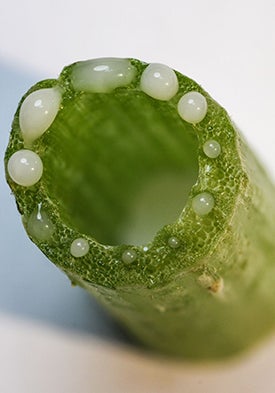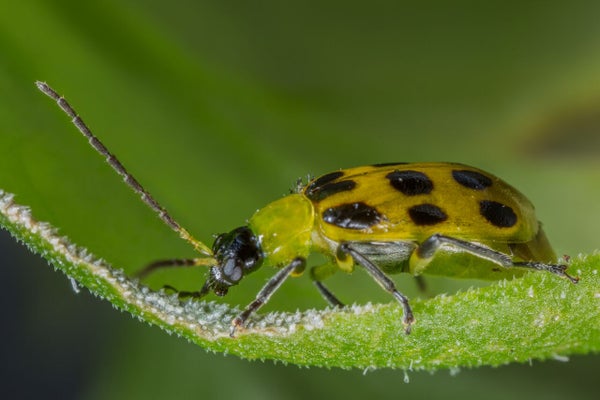Gird your gourds. A deadly bacterium transmitted via beetle poop is threatening bright blossoms and bulbous vegetables in the U.S. By the time yellowing leaves and signs of wilting become apparent it is already too late. At that point infected pumpkins, melons, cucumbers or squash plants can only be isolated in hope of minimizing the damage. Crop yield losses can be as high as 80 percent.
The killer, a bacterium called Erwinia tracheiphila, was first described in scientific literature some 120 years ago when it was reported in cucumber, melon and winter squash fields in Michigan. But now the increasing acreage of these plants, along with the practice of sowing more fields with one or a few crops—rather than a wide variety—appear to have helped the microbe gain traction. It is currently being blamed for tens of millions of dollars in losses each year. “To be honest, it’s in every field I go to in the Northeast and mid-Atlantic, unless the plants are completely doused in pesticides,” says Lori Shapiro, an evolutionary ecologist who researches the involved bacterium at North Carolina State and Harvard universities. These virulent microbes have also taken out gourds and melons across Kentucky and Iowa. Agricultural experts remain concerned the bacterium might creep into new areas like the southeastern or southwestern U.S. as well as Mexico—and wonder if it already has.
Such hazards are rekindling interest in studying this killer bacterium. And recent discoveries by Shapiro and colleagues are providing fresh insights into how these microbes hijack their hosts and manipulate insect behavior to help E. tracheiphila proliferate. Armed with this information, farmers and researchers hope they might be able to develop some new weapons against this stealthy scourge.
On supporting science journalism
If you're enjoying this article, consider supporting our award-winning journalism by subscribing. By purchasing a subscription you are helping to ensure the future of impactful stories about the discoveries and ideas shaping our world today.
A Bug’s Life
In many ways the microbe’s rise is an exquisite evolutionary feat. These pernicious pests catch a ride to gourds and other hosts such as cantaloupe and honeydew melon, courtesy of beetle excrement.When beetles nibble on leaves and then deposit their feces there, the bacteria jump from poop to plant. They enter their victim via the fresh, bite-induced wounds produced by their grazing hosts. Then they hole up inside the plant’s veins, multiplying and forming a slimy mass that obstructs water from moving through its vasculature. The blockage desiccates and kills the gourd—much in the same way a blockage in a human vein might lead to heart failure or coronary heart disease, Shapiro explains. “If our arteries are clogged by plaque and blood can’t get through, you may die. Similarly, the xylem (veins) are blocked here so that the plant collapses and dies—although the time scales are a bit different. In both cases the vasculature no longer works.”
The obstruction leaves the plants with an unquenchable thirst. No matter how much water a farmer might provide, once the bacteria have a foothold it will never be enough, says Mark Gleason, a plant pathologist at Iowa State University. “It’s pretty much a death sentence. No water can flow. Sometimes they recover at night and look better, but that’s just an intermediate stage,” he says. The victim will be dead within about two weeks, depending on the temperature.

Infection with Erwinia tracheiphila clogs this zucchini plant's veins and prevents the flow of sap. The pictured white ooze is purely bacteria—not sap or any substance produced by the plant. Credit: Scott Chimileski
Right now, options to stop these microbial attackers are few: The bacteria do not survive on plant surfaces, so they cannot be targeted there. The only consistent defense is attacking the beetle carriers—preemptively applying neonicotinoid pesticides to plants to prevent beetles from feeding on them and depositing the bacteria. The catch is that these bug killers have also been shown to harm the bees that would otherwise help pollinate those same plants, says Andrew Stephenson, an evolutionary ecologist at The Pennsylvania State University. Using pesticides in a way that minimizes damage to bees remains challenging, Stephenson notes. Moreover, regularly applying such chemicals can be expensive—and is obviously not an option for organic farmers. (Many organic farmers use row covers to physically separate beetles from plants, but that is an expensive and cumbersome solution.) With pesticides, “I would say we are using a sledgehammer to defeat a fly, and we need something a bit more attuned and effective,” Gleason agrees.
Bee harm is also at the heart of a current debate at the U.S. Environmental Protection Agency about restricting pesticide use during plant flowering to avoid inadvertently killing pollinators. The issue has fomented risk assessments along with some limited new policies, but environmental groups are hoping for more controls. “It seems unlikely that [such] regulation will be enacted in the next couple of years, but if it ever is, that would likely mean that chemical pesticides would be useless for controlling vector populations,” ecologist Shapiro says.
Genetic Footprints
In their search for solutions Shapiro and colleagues have in recent years turned to E. tracheiphila’s genome and the ways the bacterium influences beetle behavior. The researchers have already uncovered some surprising insights. In September 2012 Shapiro and researchers at Penn State found beetles actually preferred to sup on plants already infected with the bacterium. They discovered infected plants give off volatile compounds that apparently smell delicious to the bugs—attracting them to feed and forcing the plant to become a party to its own demise.
The microbe has other tricks, too. To help ensure the beetles will stay, dine and deposit feces, the bacterium also degrades its host’s natural defenses—making the plant even more alluring for still more beetles. Infected gourds and melons apparently produce less of a gummy sap that would otherwise leave a beetle’s mouth feeling too sticky to keep eating. Scientists are unsure why there is less of the sticky stuff in infected plants, but one leading hypothesis is that the reduced water flow reduces that syrupy supply.
Beyond breaking down beetle behavior, Shapiro and colleagues are also scouring the E. tracheiphila genome, looking for virulence genes that have helped make the microbe a better killer. Her team published findings last year that suggest the bacterium has only recently started consistently preying upon these crops. Writing in Genome Biology and Evolution, they pointed to the fact that more than 20 percent of the pathogen’s genome is composed of nonfunctioning genes—pseudogenes that do not appear to be doing important work. This suggests the microbe’s focus on these plants must have been relatively recent on the evolutionary scale because those nonfunctional genes would likely have been eliminated as negative pressure pushed them out over time, the authors wrote. The team hypothesizes the leap to these crops from a different ecological niche—and subsequent genomic changes—may have been influenced by the large-scale single-crop farming practices that have proliferated across the U.S. That, in combination with beetles being easily able to flit from one plant to its neighbor, may have lit the match for this threat, they suggest.
But what can be done? One path may be trying to identify resistance genes, Gleason says. Researchers do not know why the blight has apparently not spread to (or at least not been detected) in Texas or California, even though there are available crops and possible bug carriers in those states. These factors suggest there may be some genetic resistance or other factors about potential beetle carriers that could be explored.
For now, however, Shapiro and colleagues have put out a call to citizen scientists and farmers, asking them to send in sick gourd and melon plants (those that do not rebound after watering). More widespread E. tracheiphila samples, they hope, will allow them to better understand the full range of this bacterium and launch further genomic studies. Perhaps then, we can better prepare pumpkins and other plants for future attacks.
